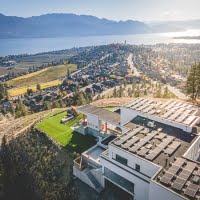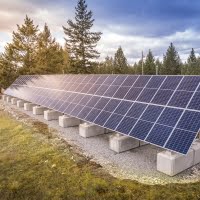SO, YOU ARE INTERESTED IN SOLAR FOR YOUR HOME
UPDATE: The Federal Government has recently made changes to the Greener Homes Initiative. The grant portion of the program is no longer available. However, you can still access up to $40,000 in interest free loans. To be eligible for the program check the criteria on the program website or ask your solar advisor.
Solar power is a hot topic these days. As people are looking for ways to save money on their electric bill, more and more are turning to solar energy to help offset their utility usage. But how does it all work? And what do you need to consider for having solar installed on your home? Read on for some information about grid-tied rooftop solar that will help you decide if it is right for you.
What is rooftop solar and how does it work?
Rooftop solar means a solar panel system that is installed on your roof. The majority of residential systems in British Columbia are roof-mounted, grid-tied and registered in a net-metering program.
PV (photovoltaic) cells convert the sun’s energy to create electricity. A group of PV cells are combined to form solar modules or solar panels. A group of solar panels connected together forms an array. A complete solar energy system also includes mounting structures that fasten the panels to the roof, along with the components that take the direct-current (DC) electricity produced by modules and convert it to the alternating-current (AC) electricity used to power all of the appliances in your home.
The benefits of rooftop solar
There are a number of benefits to rooftop solar, including:
- Reduction in your electric bill – One of the biggest benefits of grid-tied solar is that it can reduce your electric bill by a significant amount. Net metering allows consumers to generate some or all of their own electricity to use anytime, instead of when it is generated. When you generate more than you need, you feed it back to the grid and get a net credit towards future electricity use.
- Independence from the grid – Rooftop solar also allows you to be more independent from the grid. By producing your own electricity, you are securing your long-term cost of energy. With systems warrantied for 25 to 30 years, it is a secure long-term investment.
- Environmental benefits – The sun’s energy is free and abundant, and completely renewable. Essentially it provides free power for homes (and businesses). It produces no emissions or pollution, so it will not contribute to global issues like climate change.
How much money can you save with solar?
The amount you can save will depend on several factors including the size of the array installed, how efficient it is, factors like shading, as well as the amount of electricity you consume (and the utility rate you pay). Energy Economics(TM) takes all those factors into consideration when designing your system. The average investment is between $10,000 and $30,000. It is possible to offset 100% of your electricity bill annually.
What are the requirements for rooftop solar?
In order to be eligible for grid-tied rooftop solar, you must own your home and meet a few other requirements:
- You need enough available space on your house to accommodate the solar modules.
- Your property must be connected to the grid.
- The electrical panel has to have adequate room for connecting the solar energy.
However, if you do not meet these requirements there are still other options available, including a ground mounted system, an off-grid system, and upgrading your electrical panel.
Why rooftop solar is a good investment
Rooftop solar panels can save you money on your electric bill by providing you with some or all of your electricity needs. Solar is an appreciating asset; the value of your solar energy system keeps increasing each year as utility prices inflate. The return on investment is typically between 6 and 9 percent.
The process of installing rooftop solar
The first step is to determine how much space is available for the solar panels and any issues that would affect solar production such as shading from trees or nearby structures. The roof material should be in good condition. Since solar will be on the roof and producing energy for the next quarter century plus, you don’t want to install it on a roof that needs to be replaced in 10 years.
Your solar installer will look at the angle of the roof (pitch) and the orientation to South. They will look at your utility bills and examine the main electrical panel. Once that’s done, the installer will need to determine what type of system will work best for your home and present options for you.
Once agreed upon, the solar company will schedule and complete the work. The final step is commissioning the system and connecting it to the net-metering program.
Maintenance and care for rooftop solar panels
Once your rooftop solar system is installed, it is mostly maintenance free. There are no moving parts. Routine maintenance can include cleaning the panels and checking the inverter and wiring. Oftentimes, rain is enough to keep the panels clean enough. In the winter, if snow builds up it can be removed with a nonabrasive broom though the minimal impact of snow on annual solar production means it is not usually worth the risk of climbing on a snowy roof. The reporting software enables you to monitor your energy production to ensure everything is working and if anything needs to be checked.
Rooftop solar is a great investment for homeowners and businesses looking to save money on their monthly electric bill. Rooftop solar panels also contribute to lowering greenhouse gas emissions and combating global warming. The first step is to determine which type of rooftop system would work best for your home or business. A custom design by a quality installer will ensure the maximum return on your investment.
Contact Energy Economics™ for a free, custom quote.


